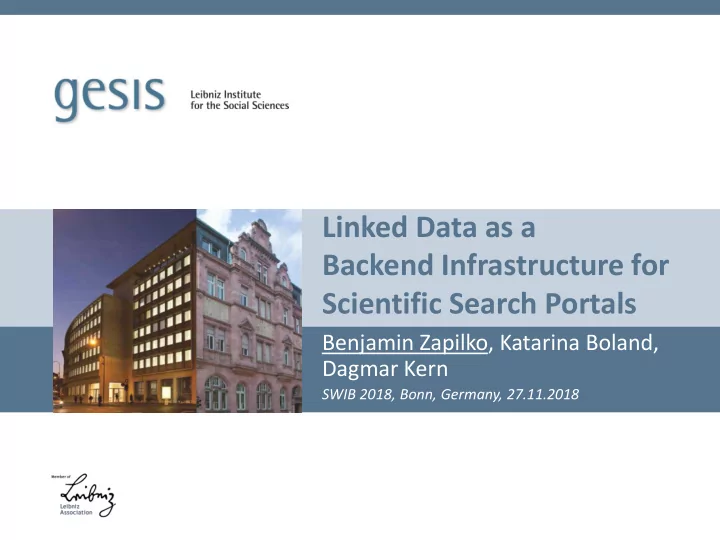

Linked Data as a Backend Infrastructure for Scientific Search Portals Benjamin Zapilko, Katarina Boland, Dagmar Kern SWIB 2018, Bonn, Germany, 27.11.2018
Searching for research information Different research information is available in different databases instrument publication dataset Database Database Database
User survey 337 social science researchers in Germany Researchers are interested in links between information of different types and different sources publication dataset „I‘m looking for research data mentioned in a paper.“ „I‘m looking for information (134 participants) which variables are included in a particular research dataset.“ (163 participants)
LOD backend infrastructure publication dataset instrument LOD Backend Database Database Database
LOD backend infrastructure Features Collecting existing links between research objects from different data sources Generating new links by link detection algorithms Data is modelled as Linked Open Data Links and attached information is available for search portals via a search index Existing search portals and their underlying infrastructures are not affected
Architecture Parts of this infrastructure are based on the project InFoLiS funded by DFG: http://www.infolis.gesis.org
Data model Basic classes: Entity and EntityLink Extension of InFoLiS data model, e.g. additional entity types <Entity 1> <Entity 2> :fromEntity :toEntity <EntityLink 1> Used vocabularies OWL, RDF/RDFS, DC, SKOS, DCAT, DQM, BIBO, PROV-O
Entities Basic metadata about an entity, but also entity type, source, etc.
EntityLinks Source and target of a link Type of relation, e.g. “references” Provenance information: How was the link created? On which basis? How reliable is the link?
Further data processing Link detection Extraction and lookup of DOIs Pattern-based reference extraction and linking Term-based reference extraction and linking Entity Disambiguation and link merging ID matching Disambiguation of datasets by modelling relationships with a research data ontology Link merging for duplicate entities For details, see: Boland et al. (2012). Identifying references to datasets in publications.
Research Data Ontology Necessity to generate relations between different versions of a research dataset „German General Social Survey (ALLBUS) - <Dataset 1> :label Cumulation 1980- 2010“ :part_of_temporal :part_of_methodical „ German General Social Survey - ALLBUS 2000 - <Dataset 2> :label CAPI-PAPI “ :part_of_methodical „ALLBUS/GGSS 2000 PAPI (Allgemeine Bevölkerungsumfrage <Dataset 3> der Sozialwissenschaften/German :label Source: General Social Survey 2000 PAPI)“ http://www.infolis.gesis.org
Link database and search index Database: MongoDB 108435 documents Search index: Elasticsearch 277678 links
Scientific search portal http://search.gesis.org
Evaluation Evaluation of user experience Scenario: GESIS search portal, http://search.gesis.org User study 17 participants from German universities 7 female, 10 male Average age 33.35 years 3 professors, 4 postdocs, 9 research associates, 1 student assistant Recruitment by email
Evaluation 2 steps (both think-aloud method): 1. Prescribed evaluation scenario to familiarize participants with interlinked information 2. Free exploration phase Survey at the end regarding Usefulness Trust in provided links Completeness of linked information Origin of linked information
Results Usefulness Trust in provided links 14 12 3 10 8 yes 6 4 no 2 14 0
Results Completeness Origin of links 3 5 yes yes no no 12 14
Challenges After following a couple of links Users may get lost and have difficulties to find their starting point Relation to original information gets lower
General applicability All components have been developed independently of any specific portal or metadata All components can be reused independent from each other as web service via the API Extensible architecture New data sources = new importers / harvesters Extensible data model For including new information types Source code: http://github.com/infolis
Future Work Switching from MongoDB to a triple store Linking with thesauri, authority data and external knowledge graphs Author disambiguation Acknowledgements Parts of the infrastructure, the data model, and the Research Data Ontology have been developed jointly with University Library Mannheim , University Mannheim , and Stuttgart Media University in the project InFoLiS funded by DFG: http://www.infolis.gesis.org
LOD infrastructure at GESIS: http://search.gesis.org Source code: http://github.com/infolis Contact: Dr. Benjamin Zapilko benjamin.zapilko@gesis.org Thank you for your attention!
Data import Different importers and harvesters for different sources and formats
Why a Research Data Ontology? A research dataset can be available in different aggregations and versions with different IDs „German General „ German General „ALLBUS/GGSS 2000 PAPI Social Survey Social Survey - (Allgemeine (ALLBUS) - ALLBUS 2000 - CAPI- Bevölkerungsumfrage der Cumulation 1980- PAPI “ Sozialwissenschaften/Germ 2010“ an General Social Survey 2000 PAPI)“ Necessity to generate relations between different versions of a research dataset The detected target of an EntityLink is often unprecise, e.g. “German General Social Survey 2000”
Research Data Ontology Adds new properties to the data model <Dataset 1> :fromEntity :entityRelation <Link Dataset 1 „ part_of_temporal “ Dataset 2> :toEntity <Dataset 2> :part_of_ / :superset_of_ Example temporal Cumulated over time spatial Different countries methodical Different collection methods sample Subsamples confidential Different privacy restrictions
Link database Currently 108435 documents 277678 links Source: Baierer et al (2015): A RESTful JSON-LD Architecture for Unraveling Hidden References to Research Data
Link transformation Flattening of indirect links for efficient queries
Recommend
More recommend